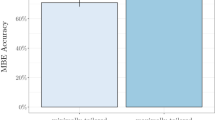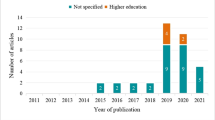Abstract
This paper explores the application of deep learning in automating the scoring of open-ended candidate responses to pre-hire employment selection assessments. Using job applicant text data from pre-employment virtual assessment center exercises, three algorithmic approaches were compared: a traditional bag of words (BoW), long short-term memory (LSTM) models, and robustly optimized bidirectional encoder representations from transformers approach (RoBERTa). Measurement and assessment best practices were leveraged in the development of the candidate assessment items and human labels (subject matter experts’ (SME) ratings on job-relevant competencies), producing a rich set of data to train the algorithms on. The trained models were used to score the candidate textual responses on the given competencies, and the level of agreement with expert human raters was assessed. Using data from three companies hiring for three different occupations and across seven competencies, three algorithmic approaches to automatically score text were evaluated, showcasing correlations between SME and algorithmically scored competencies on holdout samples that were very strong (avg r = 0.84 for the best performing method, RoBERTa) and nearly identical to the inter-rater reliability achieved by multiple expert raters following consensus (avg r = 0.85). Criterion-related validity, subgroup differences, and decision accuracy are investigated for each algorithmic approach. Lastly, the impact of smaller sample sizes to train the algorithms is explored.


Similar content being viewed by others
References
Aghajanyan, A., Shrivastava, A., Gupta, A., Goyal, N., Zettlemoyer, L., & Gupta, S. (2020). Better fine-tuning by reducing representational collapse. https://arxiv.org/abs/2008.03156
American Educational Research Association. (2014). American Psychological Association, Joint Committee on Standards for Educational, Psychological Testing (US), & National Council on Measurement in Education. In Standards for educational and psychological testing. American Educational Research Association.
Benaich, N & Hogarth, I. (2020). State of AI report. https://www.stateof.ai/
Binning, J. F., & Barrett, G. V. (1989). Validity of personnel decisions: A conceptual analysis of the inferential and evidential bases. Journal of Applied Psychology, 74(3), 478. https://doi.org/10.1037/0021-9010.74
Booth, B. M., Hickman, L., Subburaj, S. K., Tay, L., Woo, S. E., & D'Mello, S. K. (2021, October). Bias and fairness in multimodal machine learning: A case study of automated video interviews. In Proceedings of the 2021 International Conference on Multimodal Interaction (pp. 268–277).
Campion, E. D., & Campion, M. A. (2020). Using computer-assisted text analysis (CATA) to inform employment decisions: Approaches, software, and findings. In Research in Personnel and Human Resources Management (Vol. 38, pp. 285–325). Emerald Publishing Limited. https://doi.org/10.1108/S0742-730120200000038010
Campion, M. C., Campion, M. A., Campion, E. D., & Reider, M. H. (2016). Initial investigation into computer scoring of candidate essays for personnel selection. Journal of Applied Psychology, 101, 958–975. https://doi.org/10.1037/apl0000108
Chollet, F. (2015). Keras. https://github.com/fchollet/keras
Devlin, J., Chang, M. W., Lee, K., & Toutanova, K. (2019). BERT: Pre-training of bidirectional transformers for language understanding. In Proceedings of the 2019 Conference of the North American Chapter of the Association for Computational Linguistics. Human Language Technologies (pp. 4171–4186). Minneapolis.
Douglas, E. F., McDaniel, M. A., & Snell, A. F. (1996). The validity of non-cognitive measures decays when applicants fake. Proceedings of the Academy of Management, 127–131.
Dudley, N. M., & Cortina, J. M. (2008). Knowledge and skills that facilitate the personal support dimension of citizenship. Journal of Applied Psychology, 93(6), 1249–1270. https://doi.org/10.1037/a0012572
Edwards, B. D., Day, E. A., Arthur Jr., W., & Bell, S. T. (2006). Relationships among team ability composition, team mental models, and team performance. Journal of Applied Psychology, 91(3), 727–736. https://doi.org/10.1037/0021-9010.91.3.727
Goodfellow, I., Bengio, Y., & Courville, A. (2016). Deep learning. Cambridge: The MIT Press.
Gray, S., Radford, A., Kingma, D. (2017). Gpu kernels for block sparse weights. https://cdn.openai.com/blocksparse/blocksparsepaper.pdf
Hausknecht, J. P., Day, D. V., & Thomas, S. C. (2004). Applicant reactions to selection procedures: An updated model and meta-analysis. Personnel Psychology, 57(3), 639–683.
Hochreiter, S., & Schmidhuber, J. (1997). Long short-term memory. Neural Computation, 9(8), 1735–1780. https://doi.org/10.1162/neco.1997.9.8.1735
LawGeex. (2019,). AI vs. lawyers: The ultimate showdown. https://blog.lawgeex.com/resources/whitepapers/aivslawyer
Lievens, F., Sackett, P. R., Dahlke, J. A., Oostrom, J. K., & De Soete, B. (2019). Constructed response formats and their effects on minority–majority differences and validity. Journal of Applied Psychology, 104(5), 715.
Liu, Y., Ott, M., Goyal, N., Du, J., Joshi, M., Chen, D., Levy, O., Lewis, M., Zettlemoyer, L., & Stoyanov, V. (2019). RoBERTa: A robustly optimized BERT pretraining approach. Arxiv: https://arxiv.org/pdf/1907.11692.pdf
McKinney, S. M., Sieniek, M., Godbole, V., Godwin, J., Antropova, N., Ashrafian, H., Back, T., Chesus, M., Corrado, G. C., Darzi, A., Etemadi, M., Garcia-Vicente, F., Gilbert, F. J., Halling-Brown, M., Hassabis, D., Jansen, S., Karthikesalingam, A., Kelly, C. J., King, D., et al. (2020). International evaluation of an AI system for breast cancer screening. Nature, 577(7788), 89–94. https://doi.org/10.1038/s41586-019-1799-6
Mikolov, T., Chen, K., Corrado, G. S., & Dean, J. (2013). Efficient estimation of word representations in vector space. International Conference on Learning Representations. https://arxiv.org/pdf/1301.3781
Minaee, S., Kalchbrenner, N., Cambria, E., Nikzad, N., Chenaghlu, M., & Gao, J. (2022). Deep learning–based text classification: A comprehensive review. ACM Computing Surveys, 54(3), 1–40. https://doi.org/10.1145/3439726
de Oliveira, J. M., Zylka, M. P., Gloor, P. A., & Joshi, T. (2019). Mirror, mirror on the wall, who is leaving of them all: Predictions for employee turnover with gated recurrent neural networks. In Y. Song, F. Grippa, P. Gloor, & J. Leitão (Eds.), Collaborative innovation networks. Studies on entrepreneurship, structural change and industrial dynamics (pp. 43–59). Springer. https://doi.org/10.1007/978-3-030-17238-1_2
Pan, S. J., & Yang, Q. (2010). A survey on transfer learning. IEEE Transactions on Knowledge and Data Engineering, 22(10), 1345–1359. https://doi.org/10.1109/TKDE.2009.191
Pandey, S., & Pandey, S. K. (2019). Applying natural language processing capabilities in computerized textual analysis to measure organizational culture. Organizational Research Methods, 22(3), 765–797. https://doi.org/10.1177/1094428117745648
Pennington, J., Socher, R., & Manning, C. (2014). GloVe: Global vectors for word representation. In Proceedings of the 2014 Conference on Empirical Methods in Natural Language Processing (EMNLP) (pp. 1532–1543). https://doi.org/10.3115/v1/D14-1162
Phandi, P., Chai, K. M. A., & Ng, H. T. (2015). Flexible domain adaptation for automated essay scoring using correlated linear regression. In Proceedings of the 2015 conference on empirical methods in natural language processing (pp. 431–439). https://doi.org/10.18653/v1/D15-1049
Putka, D. J., Oswald, F. L., Landers, R. N., Beatty, A. S., Rodney, M. A., & Yu, M. C. (2022). Evaluating a natural language processing approach to estimating ksa and interest job analysis ratings. Journal of Business and Psychology, 2022. https://doi.org/10.1007/s10869-022-09824-0
Ramineni, C., & Williamson, D. M. (2013). Automated essay scoring: Psychometric guidelines and practices. Assessing Writing, 18(1), 25–39. https://doi.org/10.1016/j.asw.2012.10.004
Ribeiro, M. T., Singh, S., & Guestrin, C. (2016). “Why should I trust you?” Explaining the predictions of any classifier. In Proceedings of the 22nd ACM SIGKDD international conference on knowledge discovery and data mining (pp. 1135–1144).
Roch, S. G., Woehr, D. J., Mishra, V., & Kieszczynska, U. (2012). Rater training revisited: An updated meta-analytic review of frame-of-reference training. Journal of Occupational and Organizational Psychology, 85, 370–395.
Ruder, S. (2017). An overview of multi-task learning in deep neural networks. https://arxiv.org/abs/1706.05098
Rupp, D. E., Hoffman, B. J., Bischof, D., Byham, W., Collins, L., Gibbons, A., & Jackson, D. J. (2015). Guidelines and ethical considerations for assessment center operations. Journal of Management, 41(4), 1244–1273. https://doi.org/10.1177/0149206314567780
Sackett, P. R., Zhang, C., Berry, C. M., & Lievens, F. (2022). Revisiting meta-analytic estimates of validity in personnel selection: Addressing systematic overcorrection for restriction of range. Journal of Applied Psychology, 107, 2040–2068. https://doi.org/10.1037/apl0000994
Sajjadiani, S., Sojourner, A. J., Kammeyer-Mueller, J. D., & Mykerezi, E. (2019). Using machine learning to translate applicant work history into predictors of performance and turnover. Journal of Applied Psychology, 104(10), 1207–1225. https://doi.org/10.1037/apl0000405
Salgado, J. F., & Moscoso, S. (2019). Meta-analysis of interrater reliability of supervisory performance ratings: Effects of the appraisal purpose, range restriction, and scale type. Frontiers in Psychology, 10, 2281. https://doi.org/10.3389/fpsyg.2019.02281
Schmidt, F. L., & Hunter, J. E. (1998). The validity and utility of selection methods in personnel psychology: Practical and theoretical implications of 85 years of research findings. Psychological Bulletin, 124(2), 262.
Socher, R., Perelygin, A., Wu, J., Chuang, J., Manning, C. D., Ng, A. Y., & Potts, C. (2013). Recursive deep models for semantic compositionality over a sentiment treebank. In Proceedings of the 2013 conference on empirical methods in natural language processing (pp. 1631–1642).
Speer, A. (2020). Scoring dimension-level job performance from narrative comments: Validity and generalizability when using natural language processing. Organizational Research Methods, 24(3), 572–594. https://doi.org/10.1177/1094428120930815
Srivastava, N., Hinton, G., Krizhevsky, A., Sutskever, I., & Salakhutdinov, R. (2014). Dropout: A simple way to prevent neural networks from overfitting. Journal of Machine Learning Research, 15, 1929–2958.
Staudenmeyer, R. C. & Morris, E. R. (2019). Understanding LSTM: A tutorial into long-short-term memory recurrent neural networks. https://arxiv.org/abs/1909.09586
Sujan, H., Sujan, M., & Bettman, J. R. (1988). Knowledge structure differences between more effective and less effective salespeople. Journal of Marketing Research, 25(1), 81–86. https://doi.org/10.1177/002224378802500108
Taghipour, K., & Ng, H. T. (2016). A neural approach to automated essay scoring. In Proceedings of the 2016 conference on empirical methods in natural language processing (pp. 1882–1891). https://doi.org/10.18653/v1/d16-1193
Uniform guidelines on employee selection procedures. (1978). 43 Fed. Reg., 38290-38315.
Vaswani, A., Shazeer, N., Parmar, N., Uszkoreit, J., Jones, L., Gomez, A. N., Kaiser, L., & Polosukhin, I. (2017). Attention is all you need. In Proceedings of the 2017 International Conference on Neural Information Processing Systems (pp. 6000–6010).
Wang, S., & Manning, C. D. (2012). Baselines and bigrams: Simple, good sentiment and topic classification. In 50th annual meeting of the association for computational linguistics: Short papers (Vol. 2, pp. 90–94).
Wang, A., Singh, A., Michael, J., Hill, F., Levy, O., & Bowman, S. R. (2018). GLUE: A multi-task benchmark and analysis platform for natural language understanding. https://arxiv.org/abs/1804.07461
Williamson, D. M., Bennett, R. E., Lazer, S., Bernstein, J., Foltz, P. W., Landauer, T. K., & Sweeney, K. (2010). Automated scoring for the assessment of common core standards. White Paper. https://www.ets.org/research/policy_research_reports/publications/paper/2010/izph.html.
Zhu, Y., Kiros, R., Zemel, R., Salakhutdinov, R., Urtasun, R., Torralba, A., & Fidler, S. (2015). Aligning books and movies: Towards story-like visual explanations by watching movies and reading books. In Proceedings of the 2015 IEEE international conference on computer vision (ICCV) (pp. 19–27). https://doi.org/10.1109/ICCV.2015.11
Žliobaitė, I., Pechenizkiy, M., & Gama, J. (2016). An overview of concept drift applications. In N. Japkowicz & J. Stefanowski (Eds.), Big data analysis: New algorithms for a new society. Studies in big data (Vol. 16, pp. 91–114). Springer. https://doi.org/10.1007/978-3-319-26989-4_4
Author information
Authors and Affiliations
Corresponding author
Ethics declarations
Competing Interests
The authors declare no competing interests.
Additional information
Publisher’s Note
Springer Nature remains neutral with regard to jurisdictional claims in published maps and institutional affiliations.
Appendix
Appendix
Data Transparency Appendix
Portions of this paper were presented at the 2020 Annual Conference of the Society of Industrial-Organizational Psychology. Data for this study are not available because they are proprietary. Three of the variables examined in the present article have some overlap with another article currently under review (see Data Transparency Table below). For Conducting Research, the same labels and responses were used in both manuscripts. Developing Networks and Leveraging Networks are described as partially overlapping because although the same responses were leveraged, a different competency-based scoring procedure was used. In summary, of 7905 scores used to train the various algorithms in the current manuscript, 958 were scored in an identical manner in the manuscript currently under review.
Variable | MS (status = under review) |
|---|---|
Conducting Research | Overlaps |
Developing Networks | Partial overlap |
Leveraging Networks | Partial overlap |
Improving Services | No Overlap |
Reviews and Reflects | No Overlap |
Seeks Understanding | No Overlap |
Structures the Work | No Overlap |
Seeks Understanding | No Overlap |
Rights and permissions
Springer Nature or its licensor (e.g. a society or other partner) holds exclusive rights to this article under a publishing agreement with the author(s) or other rightsholder(s); author self-archiving of the accepted manuscript version of this article is solely governed by the terms of such publishing agreement and applicable law.
About this article
Cite this article
Thompson, I., Koenig, N., Mracek, D.L. et al. Deep Learning in Employee Selection: Evaluation of Algorithms to Automate the Scoring of Open-Ended Assessments. J Bus Psychol 38, 509–527 (2023). https://doi.org/10.1007/s10869-023-09874-y
Accepted:
Published:
Issue Date:
DOI: https://doi.org/10.1007/s10869-023-09874-y




